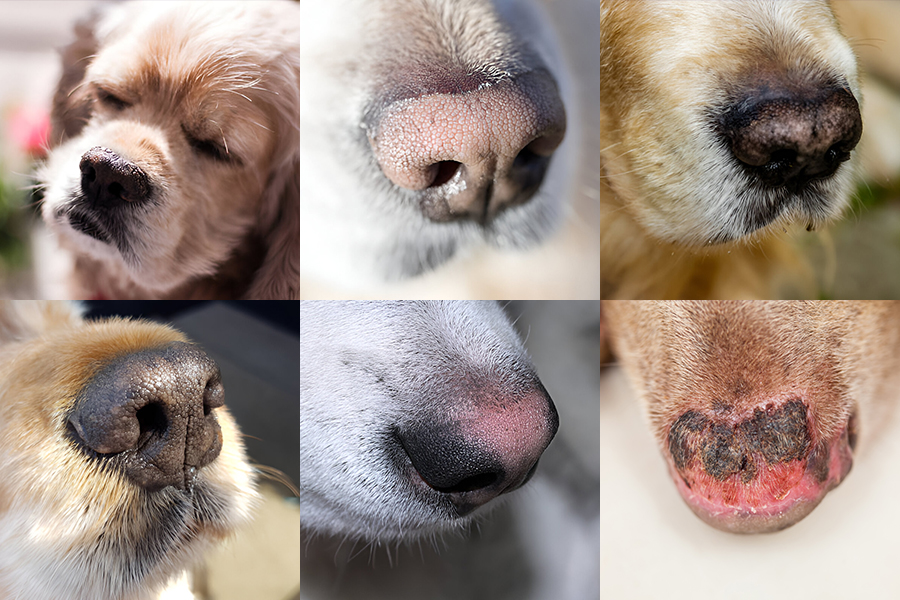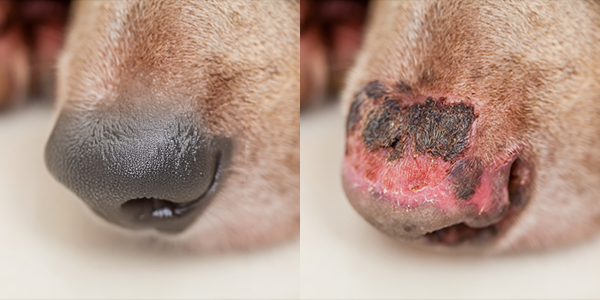
We're here for you
Emergency?
If your pet is exhibiting concerning symptoms or experiencing a medical emergency, please call our clinic at (407) 352-2579. We’ll help you through it.
One common concern for dog owners is noticing when their dog’s nose feels warm or dry. We often hear that a cool, wet nose means a dog is healthy, so what does it mean when a nose feels warmer than usual? While a warm nose might cause concern, it’s not always a sign that something’s wrong.
Why a Dog’s Nose Changes Temperature
A dog’s nose naturally varies in temperature throughout the day. Some reasons for a warm or dry nose are entirely normal and can include:
Environmental Factors
Warm or dry air, sun exposure, or sitting close to a heater can temporarily warm up your dog’s nose.
Activity Level
After a nap, your dog’s nose may be warmer than usual, as their body temperature often rises slightly during sleep.
Dehydration
If your dog hasn’t had enough water, their nose may dry out a bit. Ensure they have plenty of fresh water, especially after exercise.
Age
Puppies and older dogs may experience more fluctuations in nose temperature due to their changing metabolisms and unique needs. Puppies tend to have warmer noses, while senior dogs may have drier noses, both of which are typically normal.
Breed
Certain breeds, especially brachycephalic (flat-faced) breeds like Bulldogs and Pugs, tend to have warmer, drier noses due to their anatomy and respiratory structure. Some breeds are also more prone to dry noses, especially in warmer climates.

Which Dog Breeds Are More Prone to Warm, Dry Noses?
The following dog breeds are some that may be more prone to warm, dry noses:
- Bulldogs
- Boxers
- Pugs
- Shih tzus
- Boston terriers
- Labrador retrievers
- Dachsunds
- Chow chows
- Chihuahuas
- Golden retrievers
When a Warm Nose Might Signal a Health Issue
While a warm nose is often harmless, there are instances when it can be a sign of an underlying health issue. Here are a few conditions to watch for:
Fever
Just like people, dogs can develop fevers when fighting off infections. If your dog’s warm nose is accompanied by lethargy, loss of appetite, or unusual behavior, it’s best to check their temperature or visit a vet.
How to Check if Your Dog Has a Fever
If your dog’s nose feels unusually warm and they’re showing other signs of illness, taking their temperature is the best way to confirm if they have a fever. A normal temperature for dogs ranges from 101°F to 102.5°F. Use a pet thermometer and place it gently in the rectum, or consult your vet for guidance on proper methods to check.
Sunburn
Dogs, especially those with light-colored or thin coats, can get sunburned on their noses and other exposed areas. If your dog’s nose is warm, red, or peeling, sunburn may be to blame. Consider using a dog-safe sunscreen if they spend a lot of time in the sun. Sunburn can appear differently on different dogs, so if you notice changes to your dog's nose, you may want to consult your vet.

Allergies
Dogs can have allergies that cause a warm, irritated nose. If your dog is also sneezing, has a runny nose, or seems itchy, allergies could be the culprit.
Symptoms of Allergies in Dogs
- Sneezing
- Warm, dry nose
- Swollen face
- Itching
- Hives
- Red, irritated skin
- Itchy ears
- Vomiting
- Diarrhea
- Itchy, runny eyes
- Ear infections
- Licking constantly
Autoimmune Conditions
Rarely, certain autoimmune diseases can cause dryness and cracking around the nose. If your dog’s nose appears to be changing color or texture, let your vet know.
Pemphigus
This autoimmune disease can affect the skin, including the nose, causing dryness, cracking, and sometimes crusting or discoloration. If you notice persistent dryness or changes in your dog’s nose texture or color, consult your vet to check for conditions like pemphigus.
Compare a normal dog nose to the nose of a dog with pemphigus

Heatstroke
On hot days, a warm nose could be one sign of heatstroke, especially if your dog is panting excessively, drooling, or appears weak. Heatstroke is a serious condition and requires immediate veterinary attention to avoid dangerous complications.
Symptoms of Heatstroke in Dogs
- Excessive panting
- Dehydration
- Excessive drooling
- No urine
- Fever
- A rapid pulse
- Lethargy
- Weakness
- Muscle tremors
- Dizziness
- Vomiting
- Diarrhea
- Gums are an unusual color
Caring for Your Dog’s Nose
If your dog’s nose frequently appears dry or cracked, you can help by:
- Keeping them hydrated
- Using a pet-safe balm or moisturizer recommended by your vet
- Limiting exposure to sun or extreme temperatures
When To Contact Your Vet
If your dog’s nose remains warm over several days, or if you notice other symptoms like vomiting, diarrhea, or changes in behavior, reach out to your vet. A warm nose, on its own, usually isn’t a cause for alarm, but it can sometimes be a clue when combined with other signs.

Step One:
Call us to book your pet’s appointment.

Step Two:
Our expert vet will take care of all of your pet’s needs.

Step Three:
Get back to enjoying your happy and healthy life with your furry best friend.

Get the Best Care for Your Pet
Come Visit Dr. Qasim
Book your pet’s appointment with Dr. Qasim to ensure a long, happy life together.

We love and care for each patient as if they were our own pet.
Meet Our Team of Animal Lovers
Dr. Bilal Qasim, DVM, established Dr. Phillips Animal Hospital in 2011 after practicing veterinary medicine for over 17 years with the help of talented and caring veterinary technicians.


